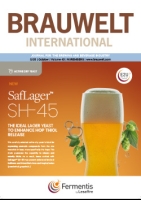Over the last decade, a drinks revolution has been felt around the world. Cider has become a global success story, and its popularity and growth show no signs of abating. The roots of this revolution can be traced back to the UK, the world’s largest cider market, home to the world’s largest cider producer and arguably the spiritual home of cider. Once a drink of the agricultural classes, cider became a commercial proposition in the early 20th century and via breweries gained national distribution. It grew to become a significant, if small drinks category. It is little wonder, therefore, that the International Brewing Awards sought to create a platform solely for cider, and to do so in 2013.
Any drink manufacturer who falls into the CO2 supply trap, has a serious problem. Without CO2, beer, mineral water or soft drinks can neither be produced nor bottled at the required quality. As a consequence, brewers and bottlers worldwide consistently strive to secure their CO2 supply. Here, CO2 recovery from beer and other fermentation processes continue to be of very high importance. CO2 recovery enables beer and beverage manufacturers to receive the highest CO2 quality, be safe from logistic and supply uncertainties, and finally in many cases, the consumer regards natural CO2 from fermentation as positive and sustainable.
Many German readers, especially those who are older, will still remember Heinz Schenk and his TV show “Zum Blauen Bock”. At least in Germany, the show had a lasting impact on how apple wine, or “Äppelwoi”, as the Germans call it, has been perceived. This reputation has recently also been extended to cider, but whether it is positive or negative is up to each individual. But what has this topic to do with beer and brewing? With all that’s happening in the “brewing world”, why is BRAUWELT International publishing an article about cider? The reason is clear: a brewery meets almost all of the prerequisites for cider production.
There were not many compelling reasons for AB-InBev to take over SABMiller, except for one: AB-InBev wanted SABMiller’s African business. If projections hold true, the African continent with its 1.2 billion people will become a critical driver for the future growth of AB-InBev’s business. Between 2015 and 2025 beer volumes in Africa are expected to rise over 30 million hl to reach to 175 million hl. With global beer volumes in decline since 2013 all hopes now rest on Africa to replace China as the driving force in the brewing industry. Imagine that: brewers will be saved by Africa, a continent that has long struggled to shake off its image as ‘lost’.
The 12th Trends in Brewing took place in Ghent from April 3rd to 7th, 2016 (see BRAUWELT International 3 2016, pp. 192-195). The leading theme of the event was “Diversity of Beers and Beer Styles”, and the keynote speeches from Prof. Ludwig Narziß, TUM-Weihenstephan, Germany, Chuck Skypeck, Brewers Association, USA, Chonlada Manakul, Boonrawd Brewery, Thailand, and Christian von der Heide, Newlands Systems, Canada, provided a good overview on beer diversity in the various continents. The four speeches are summarised below, exclusively for our readers.
At the end of November last year, AB InBev surprised analysts with a sales announcement. With reference to antitrust regulations, the focus was all of a sudden on three European shareholdings – Peroni, Grolsch and Meantime – in the context of the SABMiller takeover. After, initially, a lot pointed towards a Private Equity (PE) deal, Asahi was ultimately successful. At a glance, this is nothing but another puzzle piece in global market consolidation but it has the potential of having far-reaching consequences for the European brewing sector.
While over in the US craft brewers are eying the impending merger of AB-InBev and SABMiller warily, craft brewers in South Africa are genuinely worried. Although SABMiller controls nearly 90 percent of the local market, it has proved a friendly competitor, essentially refraining from throwing its weight around. How craft brewers will fare once the Brazilians take over is a much debated topic these days. Will they come in and start buying up breweries as they have in the US, or will they try to nip the local craft beer industry in the bud to ensure it never poses a threat to their business?
Some four centuries ago, French explorers discovered the vast wilderness on either side of the mighty St. Lawrence River, one of the great waterways that drain the North American continent. Most were colonizers like Samuel de Champlain, considered the founder of Canada, or coureurs de bois (scouts) like Étienne Brûlé, who discovered four of the five Great Lakes. These daredevils had brought with them not only their spirit of adventure, fortitude, and commercial ambitions, they also planted the French culture in the New World… and that culture has survived to this day in the French-speaking Canadian Province of Quebec. Naturally, when it comes to beverages, you would think that the alcoholic drink of choice of modern Québécois is classic French, that is, wine. Yet it is not so: A surprisingly large number of European Beer Star winners hail from this area.
When asking your average man in the pub about the beer he likes best, the answer frequently does not refer to any specific type but simply to “a fresh draught beer”.
It’s a funny world out there. Remember when InBev bought Anheuser-Busch in 2008? Almost all the world took note. Seven years on, AB-InBev’s proposed USD 100 billion plus takeover of SABMiller received little to no attention outside the business pages. Although it is the ultimate deal that reeks of size for size’s sake, AB-InBev’s eventual world domination in beer will merely be a welcome side-effect. According to analysts, AB-InBev’s real reason for buying SABMiller was laughably absurd. They could not get Coca-Cola at this point and took the opportunity to bulk up instead.


